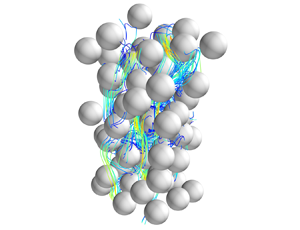Article contents
Competing flow and collision effects in a monodispersed liquid–solid fluidized bed at a moderate Archimedes number
Published online by Cambridge University Press: 28 September 2021
Abstract

We study the effects of fluid–particle and particle–particle interactions in a three-dimensional monodispersed reactor with unstable fluidization. Simulations were conducted using the immersed boundary method for particle Reynolds numbers of 20–70 with an Archimedes number of 23 600. Two different flow regimes were identified as a function of the particle Reynolds number. For low particle Reynolds numbers ( $20 < Re_p < 40$), the porosity is relatively low and the particle dynamics are dominated by interparticle collisions that produce anisotropic particle velocity fluctuations. The relative importance of hydrodynamic effects increases with increasing particle Reynolds number, leading to a minimized anisotropy in the particle velocity fluctuations at an intermediate particle Reynolds number. For high particle Reynolds numbers (
$20 < Re_p < 40$), the porosity is relatively low and the particle dynamics are dominated by interparticle collisions that produce anisotropic particle velocity fluctuations. The relative importance of hydrodynamic effects increases with increasing particle Reynolds number, leading to a minimized anisotropy in the particle velocity fluctuations at an intermediate particle Reynolds number. For high particle Reynolds numbers ( $Re_p > 40$), the particle dynamics are dominated by hydrodynamic effects, leading to decreasing and more anisotropic particle velocity fluctuations. A sharp increase in the anisotropy occurs when the particle Reynolds number increases from 40 to 50, corresponding to a transition from a regime in which collision and hydrodynamic effects are equally important (regime 1) to a hydrodynamic-dominated regime (regime 2). The results imply an optimum particle Reynolds number of roughly 40 for the investigated Archimedes number of 23 600 at which mixing in the reactor is expected to peak, which is consistent with reactor studies showing peak performance at a similar particle Reynolds number and with a similar Archimedes number. Results also show that maximum effective collisions are attained at intermediate particle Reynolds number. Future work is required to relate optimum particle Reynolds number to Archimedes number.
$Re_p > 40$), the particle dynamics are dominated by hydrodynamic effects, leading to decreasing and more anisotropic particle velocity fluctuations. A sharp increase in the anisotropy occurs when the particle Reynolds number increases from 40 to 50, corresponding to a transition from a regime in which collision and hydrodynamic effects are equally important (regime 1) to a hydrodynamic-dominated regime (regime 2). The results imply an optimum particle Reynolds number of roughly 40 for the investigated Archimedes number of 23 600 at which mixing in the reactor is expected to peak, which is consistent with reactor studies showing peak performance at a similar particle Reynolds number and with a similar Archimedes number. Results also show that maximum effective collisions are attained at intermediate particle Reynolds number. Future work is required to relate optimum particle Reynolds number to Archimedes number.
- Type
- JFM Papers
- Information
- Copyright
- © The Author(s), 2021. Published by Cambridge University Press
References
REFERENCES
- 14
- Cited by



